Historical Figures

Jacob Weller BS
1775 - 1846One of the most influential of Thurmont’s 18th Century residents.There were two Weller tribes in the early settlement era, the first led by Jacob “the Moravian” and the second by John. John’s son, Jacob, was father to Jacob BS. Jacob BS married Anna Weller, granddaughter of Jacob the Moravian and daughter of another Jacob, which integrated the two families to a degree. To distinguish himself from the other Jacob Wellers, Jacob BS took to adding the initials for blacksmith after his name.
In 1805 Jacob BS bought land along what now is West Main Street, which was adjacent to the farmstead established by his grandfather, John, in the 1740s. On the north side of the street he built what is believed to be the first tavern and inn in the emerging town. On the south side, he built a house and workshop. Both properties still stand today. In 1811 Jacob BS started a tool factory that appears to have been some distance apart from the typical artisan shop. In 1883 Jacob’s son-in-law offered a recollection of his life in town, which included this description of the shop in the 1830s: “There were two blacksmith shops, one of them very extensive, deserving rather the name of a factory as there were edge and a variety of other tools manufactured, there was a tilt hammer, grindstone, polishing wheel and turning lathe, all propelled by water power.”
In 1825 Weller invented the first friction matches sold in the United States. He’d seen samples of a European variety and through experiment developed a copied product, which he sold locally and through sales agents over a larger territory. He never pursued a patent for the invention, however, which subsequently went to another inventor from Massachusetts. Weller’s home on West Main has been called ‘The Match House’ for generations as a result.
Jacob BS’s first wife died from childbirth in 1816. Three children survived her. Jacob married again to a woman named Mary Love and fathered ten more children from that union, the last when he was 62 years old. He died at age 71 in 1846 and was buried next to his father in the cemetery at Weller church, which sits on property donated by the Wellers from the original land tract obtained by John Weller.
Col. John R. Rouzer
May 9, 1839 - March 25, 1914Perhaps the most prominent local resident in Thurmont history.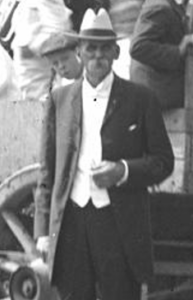
John Rouzer was born the last of ten children to Peter Rouzer and Rachel Hope Martin. His grandfather was Daniel Rouzer, who established a tannery in 1793 and became one of the town’s most successful businessmen and landowners in that era, and John’s uncle, Henry, also operated a successful tannery on East Main Street for forty years. Peter was a school teacher and headmaster as well as a farmer. John’s mother died when he was only one year old. The challenge for his father – who had six kids in the house aged 13 or younger – was too much, so John went to live with his oldest sister, Mary, who had recently married Joseph Freeze. Mary and her husband raised her infant brother like a child of their own.
After attending school, John intended to become a saddler, like his brother-in-law, Freeze. But, in August 1862 he enlisted in the Union Army after President Lincoln’s second call for volunteers. Men from Frederick County were collected into Company D of the 6th Maryland Regiment, which was led by Captain Martin Rouzer and his cousin, Lieutenant John Rouzer. Also among the 80 or so other local men was William Freeze, Mary’s oldest son and thus John’s nephew, who grew up with him in the same house and was two years younger.
John Rouzer served with distinction, earning a promotion to captain within eight months, suffering a gunshot wound at the Battle of the Wilderness, then enduring a few months as a prisoner of war before a prisoner exchange ahead of the Confederate Army’s surrender. In the summer of 1867, the United States Army awarded John successive breveted (honorary) promotions to Major and then Lieutenant Colonel for his meritorious and gallant service during the war. Neighbors, colleagues, and the local newspaper referred to him as Col. Rouzer for the remainder of his life.
He returned home to pursue the saddlery career again and quickly bought a house at 11 North Church Street. The following spring John married Harriet Wilhide. His fellow townspeople elected him into the state’s General Assembly in 1867. Sadly, Harriet died from complications of childbirth the next year (the child died four months later), and he suddenly was starting over.
Over the next 45 years, John Rouzer served six years as a state delegate for his community, ten terms as a town commissioner, four years as town postmaster, and six years as Register of Wills for Frederick County. He served on the local school board for 45 years, was among the founders of the town’s water company, including service as its president, was an officer of the Thurmont Bank, including its president, and – in 1900 – was appointed by President McKinley as deputy Register of Wills for Washington, DC, where he served for four years.
In 1871, John Rouzer married his widowed sister-in-law, Julia, whose husband was killed at Gettysburg. He raised her surviving sons as his own and together he and Julia had three surviving children as well. A fourth child died only a few days old in 1880, and a fifth died of scarlet fever in 1884 two months shy of his fifth birthday. Rouzer lived in his Church Street house until his death in 1914; Julia preceded him in death.
Peter N. Hammaker
February 27, 1858 - August 27, 1925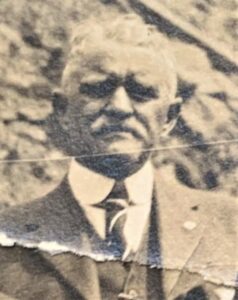
You may be familiar with Hammaker Street in Thurmont, but are you familiar with Peter Hammaker? He was born into a farming family in Washington County in 1858. After finishing school at 16, he joined his brother, Frank, in Mechanicstown (now Thurmont) where the older sibling started a marble and granite business the same year. After two years Peter left for work in Washington, DC then returned two years later, in 1878, to assume ownership of his brother’s operation. Frank started over in Libertytown, and Peter subsequently led Thurmont Marble and Granite until his death in 1925.
Peter regularly served among the group of men leading the town’s institutions – he was an organizer and then officer at Mechanicstown Water Company, an organizer and later president of the Electric Light and Power Company; an officer at Thurmont National Bank, and an officer at the Thurmont Land Improvement Company. He also led the Emmitsburg Turnpike Company for many years.
Hammaker bought the property at North Church Street and Boundary Avenue in 1879, where he subsequently built a house and moved his granite and marble yard. In 1908, he built and moved to the house at 26 North Church, just a block away, which was called among the finest houses in Frederick County at the time. He married Ida Miller in 1887, and the union produced two children who died in infancy. Ida died in 1916. At Peter’s death in 1925 his business sold to nephews Ernest and Frank, who changed its name to Hammaker Brothers. Ernest and his wife, Edith, also purchased the home at 26 North Church but eventually built their own residence off Woodland Avenue.
The Hammaker reputation thrived for decades, and the company received numerous notable commissions,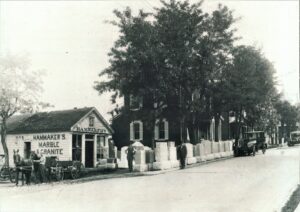 including the monument at Gettysburg commemorating the Confederate soldiers from Alabama, which was dedicated in 1933.
including the monument at Gettysburg commemorating the Confederate soldiers from Alabama, which was dedicated in 1933.
Fun fact: A stone cutter from Scotland named Robert Kinnaird joined the Hammaker operation in 1959 and brought his family to Thurmont in 1960. When the Hammaker nephews closed the company in 1964 it re-opened as R S Kinnaird Memorials, which continues in business today led by Robert’s son, John. John lives in the original Hammaker house at North Church and Boundary, too.
Judge William J. Stoner
Nov 5, 1881 - Nov 25, 1950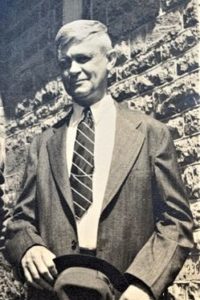
William Stoner was a son of John and Martha Stansbury Stoner. He was born on a farm near Thurmont and attended school in town. He completed a business course in Baltimore after high school but returned to work on his father’s farm, and on his twenty-second birthday married Gertrude Rouzer, who remained his companion until his death. After his marriage, Stoner was employed by his father-in-law, Daniel R. Rouzer, in the latter’s successful dry-goods store in town.
In his youth, Stoner was known to love fast horses and often challenged friends and rivals to races over country roads. He also was one of the pillars of the Frederick County Baseball League and managed several of Thurmont’s championship teams. He maintained a strong interest in baseball and regularly listened to radio broadcasts of major league games.
Judge Stoner served as Thurmont’s local Trial Magistrate for 18 years. In addition to his court duties, he also handled the sale of hunting, fishing, and dog licenses. Despite his role as adjudicator, even those against whom he ruled viewed Stoner as fair and reasonable. He held court in the basement of his house on East Main Street.
He was a life-long Democrat and for many years the head of that party in the Thurmont District. In 1919 he was elected treasurer of the Thurmont Board of Commissioners and served in that capacity until 1924 when he became president, which made him mayor. He remained mayor until 1928 then declined to serve further. In 1935, he was appointed to fill an unexpired term as mayor, which he held until 1945 when he was defeated in a close election. It was Stoner’s only lost election in 21 tries. He started losing his sight in 1931 and became completely blind in January 1936. Despite the incapacity, he managed to get around town during his latter terms as mayor and carried on his duties as magistrate with efficiency.
Stoner died at his home in November 1950 after suffering a heart attack a few days prior. The Stoner house once was among the stateliest in town, but Gertrude sold it in 1961 and it was demolished. Hobbs Hardware and Lumber occupies the same location today. Interestingly, before Gertrude’s parents bought the house in 1891 it belonged to a successful tanner named William Jones. As a demonstration of his stature, Jones installed unique panoramic wallpaper from France, which was called “Scenic America.” Before she sold the house, Mrs. Stoner sold off furniture and antiques, and one of the gentlemen who came to the sale recognized the significance of the wallpaper. Peter Hill paid $50 for the paper then spent three days removing it. Through a mutual friend at the Smithsonian Institute, Hill showed the find to Jacqueline Kennedy, who was overseeing the remodeling of the White House at the same time. Mrs. Kennedy and Hill arranged for a sale of the wallpaper to the National Society of Interior Decorators, which hung the paper in the Diplomatic Reception Room.
Russell Waesche
January 6, 1886 - October 17, 1946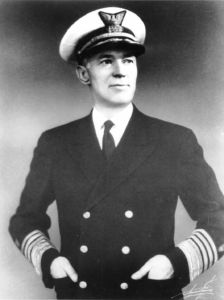
The most famous or publicly accomplished person who was born in Thurmont likely was Russell Waesche. Notably, Russell’s father, Leonard Randolph Waesche, joined the Catoctin Furnace as its bookkeeper in 1882 then became the business manager in 1887. He became general manager of the Monocacy Valley Railroad in 1897, which connected Catoctin Furnace to Thurmont and which the elder Waesche helped establish a decade earlier. Russell’s mother, Mary, was a daughter of George and Phoebe Foreman, who bought the Match House on West Main Street in 1847 and for whom Foreman’s Alley was named, which now is called South Altamont Avenue. Foreman heirs sold the property in 1904 after Phoebe’s death in 1902.
Russell graduated with the Thurmont class of 1902 then attended Purdue University in Indiana for one year before switching to the US Revenue Cutter School, which at that time was located in Curtis Bay, Maryland; some years later Waesche would play an active part in combining the Revenue Cutter service with the Life Saving service, to create the United States Coast Guard in 1915. Early in his career he served in posts around the United States as well as in Washington, DC. Waesche received his first command assignment in 1911. He served in Washington, DC during World War I then patrolled the seas during Prohibition to prevent distribution of alcohol through ports. After numerous other command roles, Waesche became the first Coast Guard officer to achieve the rank of vice admiral and admiral and served as the eighth Commandant of the United States Coast Guard between 1936 and 1945.
Waesche retired from the Coast Guard on January 1, 1946 after nearly 40 years of service and died only ten months later, on October 17, 1946, of leukemia. He is buried at Arlington National Cemetery. Just weeks after Waesche’s retirement, the secretary of the US Navy awarded him the Distinguished Service Medal, and in March 1946 President Harry Truman nominated him as one of the country’s top ten war-time generals and admirals who served during World War II.
Fun fact: After Russell left Thurmont, his parents bought the house at 108 Park Lane in 1907 from Martha Rouzer, widow of John H Rouzer, and the property stayed in the Waesche family until 1964.
George W. Wireman
November 11, 1920 - January 5, 2012
The son of George Wireman, Sr and Nellie Wireman. George graduated from Thurmont High School in 1939 then attended Hagerstown Business College in 1939 and 1940, studying accounting and business; he would catch the train every morning in Thurmont and then again every evening after school in Hagerstown. He married Charlotte Reifsnider in 1946 and remained her partner until her death in 1999.
Wireman’s first job was at Thurmont Bank, and he worked for many years at Moore Business Forms before retiring in 1985. In retirement he helped at the Cozy Restaurant, hosted a Saturday morning radio show on WTHU in Thurmont for three decades, and contributed articles to both the Catoctin Enterprise and Catoctin Banner, including his “This and That” feature that ran for years.
His love and enthusiasm for his hometown were infectious. Wireman was considered the amateur historian of Thurmont. He researched and wrote the book Gateway to the Mountains, which was published in 1969. George also spent many years during retirement volunteering for several organizations. In 1989, he received an award for 50 years of outstanding community service.
George Jr. was a long-time lover of trains, an interest he credits to his dad because the older Wireman worked for the Western Maryland Railroad. For 14 years he served as Chief (volunteer) Conductor for tourists riding the Walkersville Southern Railroad. In his home, he created an elaborate model train display called the “Monocacy Valley,” which was named after the railroad of the same name, a steam engine that ran from Frederick to Thurmont and was a branch of the Washington-Frederick-Gettysburg Railway. The train set and village occupied nearly his entire basement and included a Catoctin Mountain replica as well as miniature buildings and signs celebrating businesses in the community. He welcomed visitors every December who were interested in watching his trains operate. Ironically, for a man who loved transportation, he never held a driver’s license or drove a car.




